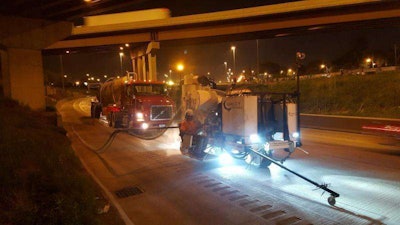 IGGA says case studies show that longitudinal diamond grooving can help improve vehicles’ traction on wet roads.
IGGA says case studies show that longitudinal diamond grooving can help improve vehicles’ traction on wet roads.Departments of Transportation across the United States are always exploring new ways of improving traction to enhance wet-weather safety while trying to contain rising costs – and longitudinal diamond grooving is one way to do it, according to a nonprofit trade group.
The group, the International Grooving and Grinding Association (IGGA), says longitudinal diamond grooving is proving itself as one strategy in localized areas where wet-pavement crashes have historically been a problem. That includes along curves and at intersections, for example.
The group says that two new IGGA case studies highlight such work in the state of Illinois. Grooving was performed on:
- 48,845 square yards of concrete pavement on Interstate 55. The treatment was installed along three separate curved highway segments near the village of Dwight (southwest of Chicago). Read the case study here.
- 61,555 square yards of concrete pavement on the Dan Ryan Expressway. The areas treated were located on a stretch of road that begins south of Canal Street and extends to Martin Luther King Drive. Read the case study here.
“Longitudinal grooving represents the most economical means of addressing friction at curves when compared to treatment alternatives such as asphalt overlays and high friction surface treatments, which can cost more than ten times the cost of grooving,” IGGA says.
“Additionally, grooving is expected to last as a finished surface for the lifetime of the concrete pavement with little to no maintenance, an attribute that cannot be claimed by overlay treatments.”
Find additional information on grooving for wet weather safety in this IGGA fact sheet, called “Put Safety First.”
IGGA is a technical and promotional resource for acceptance and proper use of diamond grinding and grooving as well as pavement preservation and restoration, according to the group.
![SR 87 and I-10 Traffic Interchange_020118_36[1] flagger road work stock](https://img.equipmentworld.com/files/base/randallreilly/all/image/2018/04/eqw.SR-87-and-I-10-Traffic-Interchange_020118_361.png?auto=format%2Ccompress&fit=crop&h=167&q=70&w=250)








